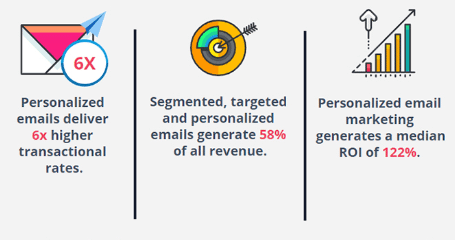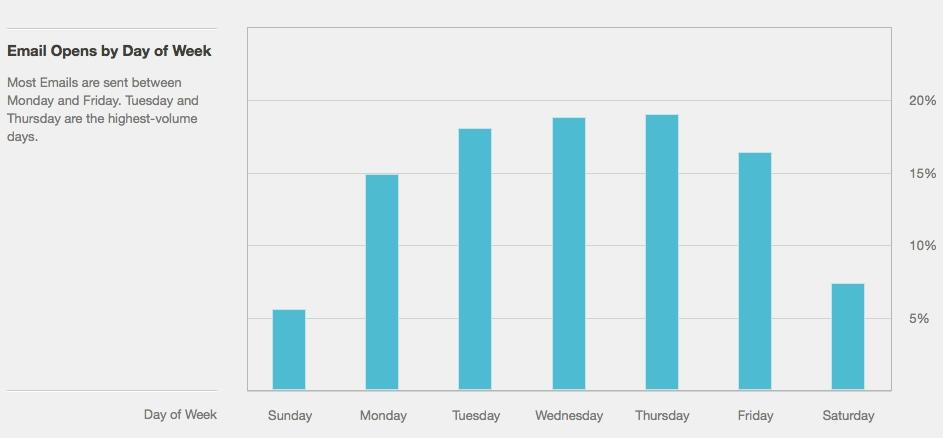Email marketing continues to be one of the top-performing channels for customer acquisition and retention by companies of all sizes. An effective way to drive results through email campaigns is to ensure that you are being honest, providing value, and adding a touch of personalization.
There are different types of emails that can be sent out and I typically categorize them as the following:
- Cold Outreach
- Nurture
- Transactional
Each of these serves a different purpose and should be aligned with an overall business goal. Aside from making it all business, within the marketing world, it’s incredibly important to figure out how each of these emails can help you:
- Better understand your audience — what they want to see from you and what drives them to further engage with your business
- Which emails are the most effective and efficient
- Which times and days work best for each
- Which types of messaging perform best
Before we dive in, let’s check out some email marketing stats that show the value of properly executing email marketing to foster growth initiatives:
- One study found that the ROI on email marketing was 28.5% compared to 7% for direct mail
- 81% of businesses say that email drives customer acquisition, and 80% for retention
- Email is 40x more effective at acquiring customers than Facebook and Twitter combined
With that in mind, let’s discuss the five ways to run successful email marketing campaigns.
1. Personalize Where You Can

Email personalization is huge when it comes to getting a better open rate and click-through rate, as well as conversions. More specifically, segmented email campaigns earn 100.95% higher clickthrough rates as compared to non-segmented email campaigns and when using proper targeting, businesses can drive 3x the revenue per email as compared to broadcasting.
In order to make this happen, here’s what I recommend:
- Segmentation by persona. Let’s say you are selling a B2B SaaS product that offers a freemium model, trial, and paid. The way you segment content to each of the personas within these buckets, as well as their lifecycle stage, is going to help you better understand what’s going to make them become a paid customer and what you can do to also help retain them.
- Have a relevant and clear CTA. Personalized calls to action convert 202% better than default calls to action. Don’t use a standard CTA across all emails. Instead, make it relatable and relevant to each persona, by lifecycle stage, and by behavior.
- Diversify your content. Figuring out the path to becoming a paid customer is important and during that process, your content should be valuable and help them along the way.
Services like Ontraport and Hubspot can be extremely helpful to help you not only design and send out emails, but also monitor open rates and click-through rates and segment the recipients based on activity. 320% more revenue is driven from automated emails than non-automated emails, so ensuring that you have an efficient email workflow can be key to your overall strategy.
2. Don’t Be Afraid of Cold Email Outreach
Email marketing isn’t just made for a list that you’ve built over months or years. You can harness the power of emails to prospect and engage with potential customers too.
I get it, some of you reading this are thinking, “Whoa! What about CAN-SPAM?” Well, let’s be clear on what you can do under the CAN-SPAM Act and how you can ensure you aren’t blacklisted or seen as spammy.
Here’s a great way to look at this by OptinMonster:
Under the CAN-SPAM Act, you can send emails to people you don’t know as long as you comply with the Federal Trade Commission’s (FTC) rules:
Be Honest
This includes being truthful about who you are and what your email is about. So, this comes down to 4 things:
- Your “From,” “To,” “Reply-To,” and routing information (including the domain name and email address) must accurately identify the person or business that initiated the email
- The subject line must accurately reflect the content of the email
- You must show that the email is an ad
- Your email must include a valid physical postal address (current street address, PO Box, or a private mailbox)
Include Opt-Out
You must include in your email an easily identifiable way for recipients to opt-out of future emails. And, you must honor opt-out requests within 10 business days.
Monitor What Others Do on Your Behalf
Even if you contract out your email marketing, you’re still on the hook legally if the company you’ve hired doesn’t comply with the CAN-SPAM Act. Make sure you know what they’re doing in your name.
3. Timing and Frequency

Just as you would plan out your entire editorial calendar when it comes to the number of blog posts or downloadable assets you plan to publish every month, plan out your email campaigns similarly.
More specifically, figure out the cadence in which you want to:
- Send a newsletter that highlights what’s happening at your company, newly published content, and any new offerings you might have.
- Send cold outreach emails along with follow-up emails. In fact, campaigns with 4-7 emails per sequence received 3X more responses than campaigns with only 1-3 emails in a sequence.
- Know which times and days are the most effective by persona for engaging with your emails.
Further, depending on which data-backed research and reports you read, many will assert the benefits of different times and days. Make sure that you put in the time to figure out what works best for you. Of course, using the studies that have already been done can give you a baseline to have an idea of what is going to help, but as you collect data of your own, you’ll have a better idea of what days and times work best for your subscribers.
Here’s a study by Mailchimp that is worth checking out:
You can see that the weekend is clearly less preferable compared to the work week, that does shift slightly depending on what type of content you send (since that affects the subscribers you have).

For example, business-related content has a less than typical number of subscribers with weekend optima. On the flip side, recreational content usually enjoys a healthier than typical percentage of subscribers with weekend send time optima. Note though that in either case, these percentages are still lower than 50%, implying that no matter what content is being sent, most lists are comprised of a majority of recipients for whom the optimal send time is during the work week.
4. Be Helpful and Drive Value
I work a ton in the B2B space, and over the years it is clear that providing valuable content that is actually helpful to your subscribers will drive more engagement with your email efforts. The notion that people want to buy from you just because you were featured on a ton of credible press sites and publications is misleading. People buy from people.
Make sure that your email marketing efforts serve as another avenue to distribute the content you develop to position your expertise and product — this is going to win over trying to hard sell. In fact, 79% of B2B marketers find email to be the most successful channel for content distribution.
Here are content assets you should absolutely share via email:
- Videos, including webinars, tutorials, product walkthroughs, and behind-the-scenes.
- White papers, guides, checklists, and data sheets.
- Upcoming virtual events you are holding and why people should attend.
- Special offerings and discounts you are running for a period of time.
- Surveys to get honest feedback from paying customers, as well as people who haven’t become customers yet but are using your product.
5. Test As Much As Possible
Seasonality, different verticals, and different personas all prefer to be communicated with in different ways and styles. For example, a more technical person may care more about the specifications of what your product offers, whereas a c-level executive may want to see a quick video of what your product can do and how it alleviates their pain point.
Either way, you’ll never have the answers to these unless you test and make testing a practice rather than a chore in your email efforts. Here are a few ideas of what you can test:
- Subject lines
- CTAs
- Copy length
- HTML vs plain text
- Gifs and images
- Different colored CTA buttons and creative assets
- Send times and days
- Messaging
Wrapping It Up
Email marketing is far from dead. However, the practices of what will drive engagement and conversions has changed. Now, it’s less about you and more about the customer. The more you’re able to develop a relationship based on putting the customer’s needs first, the higher potential you’ll see in yielding a positive ROI.
Finally, make sure that with all your implementations, you are tracking and measuring everything. Doing so will help you determine how email plays a role within your marketing initiatives as a whole.
Disclosure: Please note that some of the links above are affiliate links. I only recommend products and services that I use and stand behind, and if you decide to try them, I will earn a commission at no cost to you. Doing so helps me run this blog and provide free content for you, my readers.






4 Responses